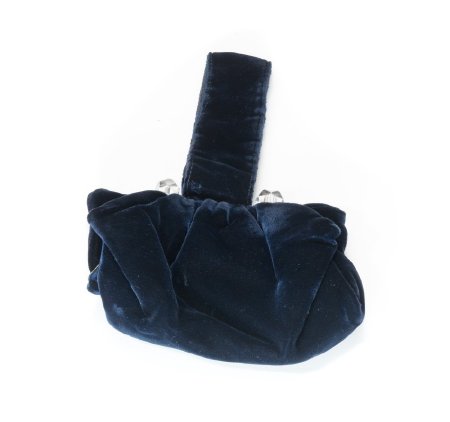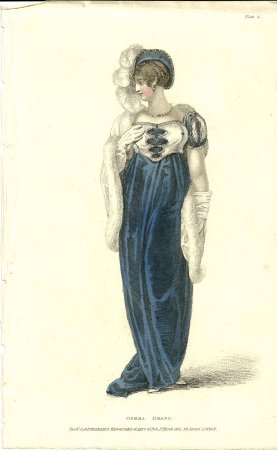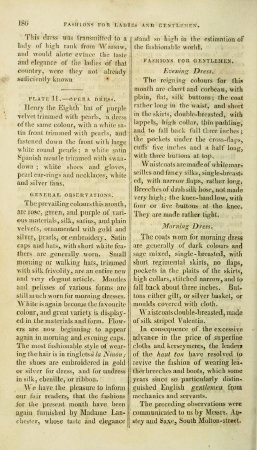Object ID:
2013.4.8
Label/Maker:
Ackermann, Rudolph
Date:
March 1, 1809
Learn More:
Object Story:
This 1809 Ackermann illustration depicts a lady in a vibrant blue velvet opera dress with a satin bodice trimmed in pearls, a square neckline, empire silhouette, and puff sleeves. The look is accentuated by pearl jewelry, a swan's-down trimmed mantle, a blue velvet hat that matches the dress, finished with white satin gloves and shoes. There is royal influence illustrated here as the hat is modeled after Henry VIII, who was known for dressing in an overtly opulent and ornate manner, even earning the title of "the best dressed sovereign in the world." 12 The aura of the Renaissance is also represented through decorative treatments such as the suggestion of slashing in the center front of the bodice and short puffed sleeves that are paned. The stylistic features of this fashion statement, combine brilliantly with the literal ideas of rebirth during the post-French Revolutionary period.
Symbolic Comparison:
What is striking about both pieces in this comparison is the deep blue velvet fabric from which they are made. Throughout time, varing shades of blue have often symbolized status, divinity, and even royalty. Blue is so prestigious a color that high-status individuals have historically been known as blue bloods.14 During the 18th century, the term blue stocking emerged to describe an upper-class, intellectual woman, and later, in the Regency era, blue suits become synonymous with dandism, a term used to describe a refined and well-dressed man.15 Additionally, revered religious figures, such as the Virgin Mary and prominent members of royalty in the 19th century, like Isabella II of Spain, are often depicted in blue.16 Similarly, velvet, especially silk velvet, has historically been accessible only to those of high status, sometimes exclusively the nobility.17 In both artifacts, the fabric seems to be used to draw attention to the wearer, displaying prestige and importance.
References:
12 Alison Weir, Henry VIII: The King and His Court, New York: Ballantine Books, 2001, p. 181.
13 "1930s Handbags and Purses Fashion," Vintage Dancer, January 10, 2017. https://vintagedancer.com/1930s/1930s-handbags-purses-history/.
14 Emma Taggart, "The History of the Color Blue: From Ancient Egypt to the Latest Scientific Discoveries," My Modern Met, February 12, 2018. https://mymodernmet.com/shades-of-blue-color-history/.
15 "The Stories of Color Blue," Fashionologia Historiana, April 12, 2018. Alison Weir, Henry VIII: The King and His Court, New York: Ballantine Books, 2001, p. 181.
16 "The Color of Royals," Google Arts & Culture, accessed November 25, 2020. https://artsandculture.google.com/usergallery/the-color-of-royals/2wKyQ40ioxf3IQ.
17 Van der Hoogt, Madelyn, "A Weaver's History of Velvet," Handwoven Magazine, September 29, 2016. https://handwovenmagazine.com/history-of-velvet/.
13 "1930s Handbags and Purses Fashion," Vintage Dancer, January 10, 2017. https://vintagedancer.com/1930s/1930s-handbags-purses-history/.
14 Emma Taggart, "The History of the Color Blue: From Ancient Egypt to the Latest Scientific Discoveries," My Modern Met, February 12, 2018. https://mymodernmet.com/shades-of-blue-color-history/.
15 "The Stories of Color Blue," Fashionologia Historiana, April 12, 2018. Alison Weir, Henry VIII: The King and His Court, New York: Ballantine Books, 2001, p. 181.
16 "The Color of Royals," Google Arts & Culture, accessed November 25, 2020. https://artsandculture.google.com/usergallery/the-color-of-royals/2wKyQ40ioxf3IQ.
17 Van der Hoogt, Madelyn, "A Weaver's History of Velvet," Handwoven Magazine, September 29, 2016. https://handwovenmagazine.com/history-of-velvet/.



